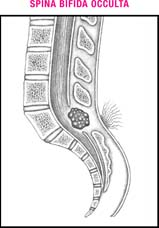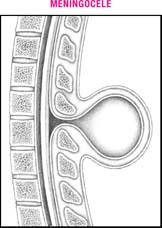Neural tube defects
Description
Birth defects that involve the spine or skull
Result from neural tube’s failure to close approximately 28 days after conception
Spina bifida (50% of cases), anencephaly (40%), and encephalocele (10%)
Also called NTD
Pathophysiology
Spina bifida occulta (least severe NTD) is characterized by incomplete closure of one or more vertebrae without protrusion of the spinal cord or meninges; more severe forms have incomplete closure of one or more vertebrae, causing protrusion of the spinal contents in an external sac or cystic lesion (spina bifida cystica). (See Types of spinal cord defects.)
Anencephaly is a closure defect that occurs at the cranial end of the neuroaxis and results in missing a part or the entire top of the skull, severely damaging the brain; portions of the brain stem and spinal cord may also be missing (fatal).
Encephalocele is a saclike portion of the meninges and brain that protrudes through a defective opening in the skull; it usually occurs in the occipital area, but may also occur in the parietal, nasopharyngeal, or frontal area.
Causes
Combination of genetic and environmental factors; possibly a lack of folic acid in the mother’s diet
Exposure to a teratogen
Part of a multiple malformation syndrome such as trisomy 18 or 13 syndrome
Types of spinal cord defects
There are three major types of spinal cord defects. Spina bifida occulta is characterized by a depression or raised area and a tuft of hair over the defect. In myelomeningocele, an external sac contains meninges, cerebrospinal fluid, and a portion of the spinal cord or nerve roots. In meningocele, an external sac contains only meninges and cerebrospinal fluid.
 |
 |
 |
Stay updated, free articles. Join our Telegram channel

Full access? Get Clinical Tree


Get Clinical Tree app for offline access
